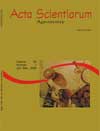<b>Growth of dry bean crop submitted to two water management and tillage systems</b> - DOI: 10.4025/actasciagron.v31i3.621
Keywords:
Phaseolus vulgaris, matrix potential, Class ‘A’ pan, tensiometer
Abstract
The dry bean has great importance to Brazilian agriculture. In addition to being a crop that meets the characteristics of family agriculture, it is also cultivated in extensive areas using high technology. Research related to the behavior and development of the bean crop in relation to regional soil and climatic variants have assumed a prominent role, especially because it is a plant that is sensitive both to the lack and excess of water in the soil. The objective of this research was to compare two methods of management of center pivot irrigation: a) soil sensor (tensiometry) and b) simplified climatological water balance – Class A pan; in conventional and no-tillage systems of soil cultivate (first year), on the irrigated dry bean winter crop growing under center pivot in succession to the corn crop in a Oxisol soil. The leaf area index (IAF), dry matter plant production and variation of the soil matrix potential were evaluated. It was concluded that both irrigation managements and tillage systems did not result in differences in IAF, nor in dry matter accumulation along the crop cycle; the tensiometry method brought on a larger variation in the soil matrix potential than the Class ‘A’ simplified climatological method.Downloads
Download data is not yet available.
Published
2009-06-23
How to Cite
Pavani, L. C., Lopes, A. da S., & Pereira, G. T. (2009). <b>Growth of dry bean crop submitted to two water management and tillage systems</b> - DOI: 10.4025/actasciagron.v31i3.621. Acta Scientiarum. Agronomy, 31(3), 453-459. https://doi.org/10.4025/actasciagron.v31i3.621
Issue
Section
Crop Production
DECLARATION OF ORIGINALITY AND COPYRIGHTS
I Declare that current article is original and has not been submitted for publication, in part or in whole, to any other national or international journal.
The copyrights belong exclusively to the authors. Published content is licensed under Creative Commons Attribution 4.0 (CC BY 4.0) guidelines, which allows sharing (copy and distribution of the material in any medium or format) and adaptation (remix, transform, and build upon the material) for any purpose, even commercially, under the terms of attribution.
2.0
2019CiteScore
60th percentile
Powered by 

2.0
2019CiteScore
60th percentile
Powered by 



















































